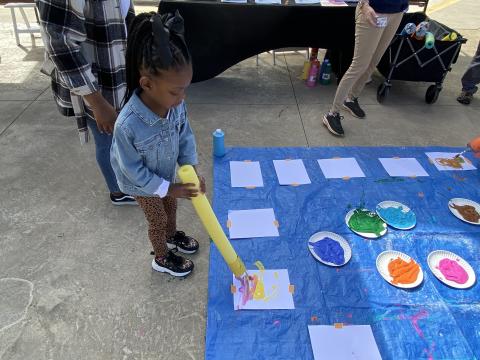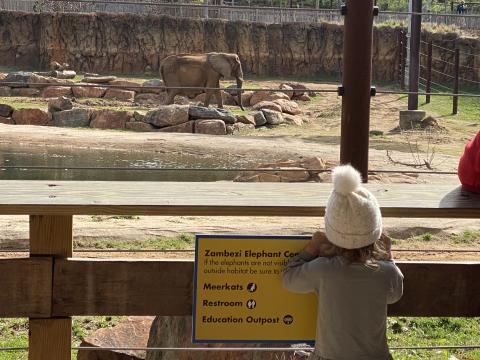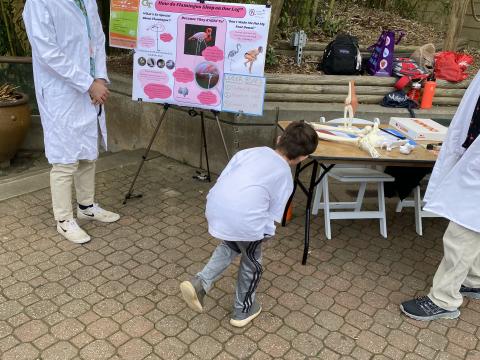On Saturday, March 11, scientists and engineers shared their biomechanics work with snakes, elephants, monkeys, flamingos, and other wildlife as part of the "Animals in Motion: Biomechanics Day at Zoo Atlanta" during the 2023 Atlanta Science Festival.
For STEAM enthusiasts across Atlanta, the month of March is a highlight of the year for one big reason: the Atlanta Science Festival. Learn more about all Georgia Tech-organized Festival events here.
Scientists and engineers study animal movements for clues on ways to improve lives for humans, such as designing better prosthetics or terrain-conquering robots. But that doesn’t mean fun can’t be a part of the research as well — as in asking kids to see how long they can stand on one leg a la flamingos.
That was the energy on display Saturday, March 11, for Animals in Motion: Biomechanics Day at Zoo Atlanta, part of the 2023 Atlanta Science Festival. With help from biomechanics researchers from Georgia Tech, Clemson University, and the University of Akron, visitors gathered at several demonstration booths around the Zoo to learn more about wildlife and work exploring animal biomechanics.
Joe Mendelson, adjunct professor in the School of Biological Sciences, is also director of Research for Zoo Atlanta. Mendelson says a Biomechanics Day was first scheduled for 2020 but ran headlong into the beginnings of the pandemic.
“Finally, we get to assemble our colleagues and highlight their fun and innovative projects,” he said, adding that the Atlanta Science Festival is the perfect place to attract researchers studying biomechanics of creatures as different as snakes, elephants, centipedes, and humans, as well.
There are many benefits to knowing more about animal locomotion. “Allowing people to see and understand familiar animals through a different light and comparing, for example, their locomotion to your own can be an effective way to generate interest and caring about animals by people,” Mendelson said.
Zoo Atlanta frequently collaborates with biomechanics researchers across Georgia's Tech's College of Sciences and College of Engineering. Animals in Motion: Biomechanics Day highlighted those labs and their various projects, as well as other labs from around the country that are doing similar research.
One of those researchers, Greg Sawicki, associate professor in the George W. Woodruff School of Mechanical Engineering and the School of Biological Sciences, used ultrasound imaging to give Zoo Atlanta visitors an “under the skin” look at how animal and human muscles work together with tendons to move the body.
“We will look at, and compare, calf muscles and the Achilles tendon in the leg with the biceps and biceps tendon in the arm,” Sawicki said. “Zoo visitors will be able to see for themselves the wide variety of structural features of muscle-tendon systems, ranging from short muscles and long compliant tendons for the calf to long muscles and short stiff tendons.”
Sawicki hoped his audience learned that different structural features of muscle-tendon systems “may have unique functional benefits in the wild — and an animal’s limb design may be specifically adapted for their environmental niche.”
Simon Sponberg, Dunn Family Associate Professor in the Schools of Physics and Biological Sciences, wasn't able to bring the live animals he works with — hawk moths — to the Animal Biomechanics Day. “It’s for a variety of reasons, but mostly that they don’t fly much during the day,” Sponberg said. But visitors to Sponberg’s booth explored different insect wing shapes to see how they help moths and other insects move.
“What we want students to get out of it is that there are many different forms and functions a ‘wing’ can take,” he added. “So we want people to learn how we can use experiments to understand the link between structure, function, and performance, especially in flight.”
At another section of Zoo Atlanta, adults and kids spent their time trying to balance on just one leg. It’s unclear if any of the nearby flamingos were impressed with the results, but Young-Hui Chang, professor and associate chair for Faculty Development in the School of Biological Sciences, says the balancing act is much easier for flamingos.
“They have to deal with the same physical challenges to stand in a stable way,” Chang said. “Biology tells us that, as vertebrates, flamingos are starting with many of the same muscles and bones of the leg that humans have. But, flamingos have evolved a way to use their limbs such that they can sleep standing on one leg with minimal involvement of the muscles, which would be impossible for us humans to do.”
Chang studies flamingo biomechanics for the sheer sake of gaining knowledge about how nature works. But he adds that there are practical applications to the research. “One that has already been used by roboticists is the development of a ‘flamingo bot’ that uses the principles we’ve discovered in the flamingo leg to help the robot conserve energy,” Chang said.
Additional Images




